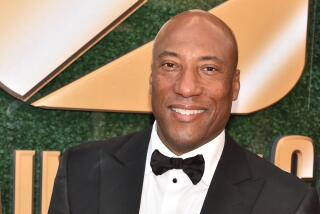Founder’s Bid for AME May Not Be Final Word
- Share via
Using aggressive service, low prices and acquisitions, Andrew M. McIntyre has built AME Inc. into one of Hollywood’s biggest providers of videotape services for movie and television studios. McIntyre has also rewarded himself, to the tune of $11 million, by selling big chunks of his AME stock to employees and the public.
McIntyre, who still owns 45% of AME, now wants to buy back the Burbank company and take it private again for $13.75 a share. That’s a shade more than the $13.50-a-share price that investors paid for the stock when it went public nearly two years ago. The stock has been a lackluster performer since, having never climbed above $13.75.
But there are signs that McIntyre’s $37-million offer might not be the last word in a possible takeover of AME.
AME’s employee stock ownership plan, or ESOP, which owns 1.23 million shares, tentatively has agreed to support McIntyre’s bid. The ESOP bought its 25% of the shares from McIntyre, who once owned all of the stock, for $4.6 million in 1985-86.
But the ESOP has also announced that it might make its own offer for the company, although that would likely occur only with McIntyre’s approval. And AME has disclosed that a third party, which it would not identify, is considering a bid for AME.
Meanwhile, McIntyre’s offer has been on the table since November, although he apparently has yet to reach terms with banks for the money he needs to finance the deal, sources close to the company say.
The delay stems from disagreements among the lenders, McIntyre and the ESOP over how much equity each might have in the company once the acquisition was completed, said the sources, who agreed to discuss the matter on the condition that they not be identified.
To muddle the picture further, McIntyre is said to look favorably on the possibility of an ESOP takeover of AME. Among other things, an ESOP buyout offers tax advantages not available to him.
“If the offer is attractive to the stockholders, he would consider it; that’s basically his words,” said Robert W. Smiley Jr., chairman of Benefit Capital Cos., which is advising the ESOP.
Started in 1980
McIntyre, who did not return telephone calls requesting an interview, started AME in 1980. The company specializes in taking movies and TV shows, which are usually shot on film, and transferring them to a master videotape. This enables them to be distributed for syndication to broadcast or cable TV, or sold to the videocassette industry.
But film-to-tape transfers are only one of AME’s post-production services. The company also provides computer animation, graphics, audio services and conversion of videotapes to the electronic standards used overseas.
McIntyre, 44, muscled his way into the big leagues of post-production by undercutting rivals’ prices and emphasizing service. AME converted films to tape faster, and the company sent messengers scurrying around town 24 hours a day to pick up and deliver studios’ programs.
“We never say ‘no’ to a client,” McIntyre said in a 1987 interview. “Never, under any conditions.”
In April, 1987, McIntyre sold 30% of AME to the public for $13.50 a share. Besides providing $6.3 million to McIntyre, the offering raised $16 million for AME, which helped the company gobble up some smaller competitors.
Profits Declined
In its fiscal year that ended Sept. 30, 1988, AME’s revenue totaled $47.6 million, up 29% from the previous year. But its profit fell 22% to $3.16 million, a decline that AME blamed mostly on the 154-day writers’ strike against major movie and TV producers last summer.
On Nov. 18, McIntyre launched his bid to reacquire the company by offering $11.50 a share for the 55% of AME that he does not own. Two non-management directors of AME, who were assigned to review the deal, found the price inadequate.
McIntyre returned with a sweetened offer of $13.75 a share, and AME announced Dec. 19 that it signed a letter of intent to merge with AOAG Inc., a company that McIntyre formed for the acquisition.
The ESOP also tentatively agreed to tender 35% to 40% of its AME shares to McIntyre and to convert the rest of its stock into equity in the new company, McIntyre has said. But the ESOP has disclosed that it is considering making its own offer.
Tax Breaks
Why? In an ESOP takeover, employees not only get a controlling voice in their company, they also get tax breaks that are not available to other buyers. For instance, banks that lend money to ESOPs for a takeover can deduct 50% of the interest income paid by the ESOP. As a result, the banks often are willing to charge a lower interest rate to the ESOP than to another borrower.
In other words, AME’s employees probably could finance a takeover more cheaply than could McIntyre. That would mean that the company would have less debt to repay.
However, an ESOP bid would be unlikely unless McIntyre dropped his bid first. Employees rarely want to compete with their founder and chairman for control. As a practical matter, the ESOP would likely proceed only if it believed that McIntyre was supportive and willing to let his bid expire first.
An ESOP buyout would not leave McIntyre in the cold. He probably could keep some equity in the new company and earn a big payoff by selling the rest of his stock in the buyout. (Based on his offer, McIntyre’s stock is worth $30.3 million.) The ESOP also would likely keep McIntyre as chief executive, if he so desired.
And how would AME’s public stockholders fare? Not bad, if they bought the stock after the 1987 stock market crash, when AME was selling for about $7 a share. But if they bought the stock when McIntyre took the company public at $13.50 a share, that’s another story.
AME’s stock has never closed at more than $13.75 since going public and, if McIntyre’s bid goes through, $13.75 a share is what they will get. So for those who bought AME when it first went public, that is a gain of 25 cents, or about 2%, on a two-year investment.
More to Read
The biggest entertainment stories
Get our big stories about Hollywood, film, television, music, arts, culture and more right in your inbox as soon as they publish.
You may occasionally receive promotional content from the Los Angeles Times.











